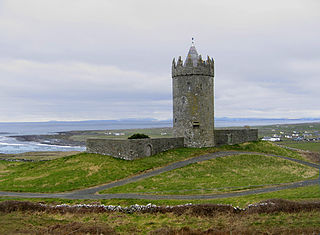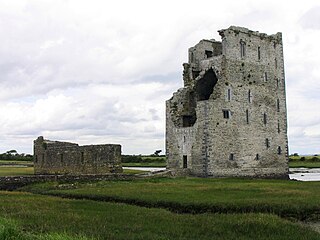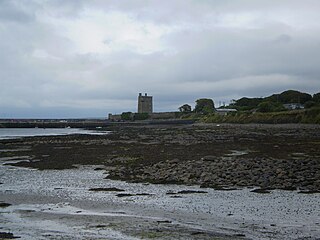
Bunratty Castle is a large 15th-century tower house in County Clare, Ireland. It is located in the centre of Bunratty village, by the N18 road between Limerick and Ennis, near Shannon Town and its airport. The castle and the adjoining folk park are run by Shannon Heritage as tourist attractions.

Castleconnell is a village in County Limerick on the banks of the River Shannon. It is 11 km (6.8 mi) from Limerick city and near the boundaries of County Clare and County Tipperary.

Cratloe is a village in County Clare, Ireland, situated between Limerick and Shannon in the mid-west of Ireland. It is possible that the name derives from Croit-shliabh meaning "hump-backed hill", referring to Woodcock Hill. The present-day parish of Cratloe consists of the former parish of Kilfintinan and a portion of the contemporary parish of Killeely. This was agreed upon by priests in the 18th century, who claimed there were not enough members of the clergy to operate fully in both parishes.

O'Dea Castle, also known as Dysert O'Dea Castle, is an Irish fortified tower house, loosely described as a castle at Dysert O'Dea, the former O'Dea clan stronghold, 5 kilometres (3 mi) from Corofin, County Clare. It was built between 1470 and 1490 by Diarmaid O'Dea, Lord of Cineal Fearmaic, and stands some 50 feet (15 m) high on a limestone outcrop base measuring 20 by 40 feet. The tower is adjacent to Dysert O'Dea Monastery, close to the R476 road.
The Battle of Dysert O'Dea took place on 10 May 1318 at Dysert O'Dea near Corofin, Ireland. It was part of the Bruce campaign in Ireland. The Norman Richard de Clare attacked the Gaelic Irish chieftain Conchobhar Ó Deághaidh, chief of the Cineal Fearmaic and ally of Muircheartach Ó Briain, but he was defeated.

Askeaton is a town in County Limerick, Ireland. The town is built on the banks of the River Deel which flows into the Shannon Estuary 3 km to the north. Askeaton is on the N69 road between Limerick and Tralee; it is 25 km west of Limerick and 8 km north of Rathkeale.

Kilrush is a coastal town in County Clare, Ireland. It is also the name of a civil parish and an ecclesiastical parish in Roman Catholic Diocese of Killaloe. It is located near the mouth of the River Shannon in the south-west of the county. Kilrush is one of the listed Heritage Towns of Ireland. The area was officially classified as part of the West Clare Gaeltacht, an Irish-speaking community, until 1956.

Clarecastle is a village just south of Ennis in County Clare, Ireland. From 2008 to 2016 the village saw a significant population increase due to its proximity to Ennis, Shannon, and Limerick.

Doonagore Castle is a round 16th-century tower house with a small walled enclosure located about 1 km south of the coastal village of Doolin in County Clare, Ireland. Its name may be derived from Dún na Gabhair, meaning "the fort of the rounded hills" or the "fort of the goats". Doonagore Castle is at present a private holiday home, inaccessible to the public.

Newcastle is a village in County Wicklow, Ireland. It is situated on the R761 and is about 45 km (28 mi) south of Dublin city. Newcastle had a population of 924 as of the 2016 census. The ancient barony of Newcastle, which surrounds the village, takes its name from the village and its Norman castle.

The siege of Carrigafoyle Castle took place on Easter in 1580 near modern-day Ballylongford, County Kerry, Ireland, on the southern bank of the Shannon estuary. The engagement was part of the English crown's campaign against the forces of Gerald FitzGerald, 14th Earl of Desmond during the Second Desmond Rebellion. The castle was held by rebel troops in the service of Desmond and some Catholic troops from continental Europe.

Ballylongford is a village near Listowel in northern County Kerry, Ireland.

Carrigaholt is a small fishing village in County Clare, Ireland, a castle and a Catholic parish by the same name. The area was officially classified as part of the West Clare Gaeltacht; an Irish-speaking community; until 1956.

Ballinalacken Castle is a two-stage tower house located in Killilagh parish of County Clare, Ireland. It is of uncertain date but most likely was built in the 15th or early 16th century.

The Shannon Estuary in Ireland is a large estuary where the River Shannon flows into the Atlantic Ocean. The estuary has Limerick City at its head and its seaward limits are marked by Loop Head to the north and Kerry Head to the south. The estuary defines the main boundary between County Kerry/County Limerick to the south and County Clare to the north.

Dough Castle is a ruined tower house at Lahinch in County Clare, western Ireland. It was established by the O'Conors in the early 14th century, but nothing remains of the original structures.

The Wild Atlantic Way is a tourism trail on the west coast, and on parts of the north and south coasts, of Ireland. The 2,500 km driving route passes through nine counties and three provinces, stretching from County Donegal's Inishowen Peninsula in Ulster to Kinsale, County Cork, in Munster, on the Celtic Sea coast.

The Shannon River Basin consists of the area containing Ireland's longest river, the River Shannon, and all of its tributaries and lakes. The official Ordnance Survey Ireland length of the Shannon from its Shannon Pot source is 224 miles (360 km) made up of 63.5 miles (102.2 km) tidal water flow and 160.5 miles (258.3 km) freshwater flow.
Shannon Rangers is a North Kerry Divisional Gaelic football team in County Kerry, Ireland, based around the Shannon Estuary. Founded in 1940, the team compete in the Kerry Senior Football Championship, which they have won on 5 occasions. They also won the inaugural Munster Senior Club Football Championship in 1964.

Lislaughtin Abbey is a medieval Franciscan friary and National Monument located in County Kerry, Ireland.






















